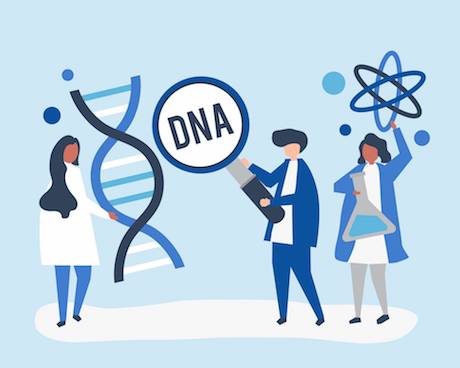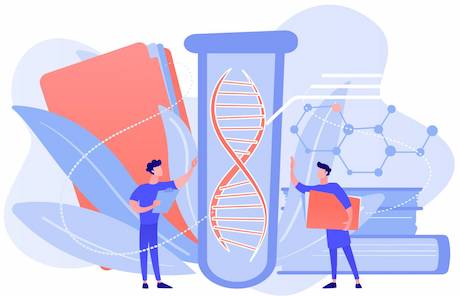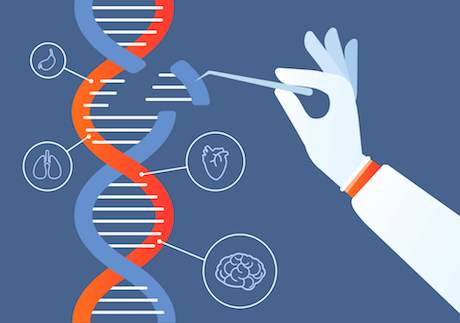By Dr. Brandon Colby MD, an expert in genetic testing, DNA analysis, and personalized medicine.
DNA is used in adoption scenarios a lot these days because of how much information it carries and how useful it can be in answering the unknown. If you’re looking for information on DNA and adoption, you’re likely in one of the following groups of people:
1. You placed a child up for adoption and now want to reunite.
2. You’re an adoptee who wants to learn about medical risks, find ancestry information or biological relatives.
3. Your sibling was adopted and you want to find him/her.
The information below can help all of the above groups of people.
How DNA and Adoption Connect

DNA is passed down from generation to generation by way of chromosomes. Each parent passes 23 chromosomes to their child, so the child receives a pair of chromosomes (one set of 23 from one parent and another set of 23 from the other parent).
DNA carries genetic information. It’s what makes each person unique. DNA influences what a person looks like, what diseases they may develop, and even how they behave.
Families often discuss who they got their eye color from with statements like, “You got your brown eyes from your mother.” Even medical professionals ask for genetic information when they ask, “Does anyone in your family have high blood pressure?”
For an adoptee, genetic information may not be available, particularly in the case of closed adoptions. A closed adoption means adoptees have no connection to their birth family. They do not know who their birth parents are nor any family members.
Adoptees don’t know who they inherited their curly or straight hair from or if their mother or father suffers from high cholesterol. They don’t know their risks for genetic diseases, so someday they also don’t know how likely it is for their children to suffer from them.
Fortunately, DNA is powerful. With advancements in genomic technology, adoptees can find out more about themselves with DNA testing. By taking a simple at-home DNA test available from DNA testing companies such as 23andMe, Ancestry.com (AncestryDNA), MyHeritage, and others, adoptees who don’t know their biological family can gain insight into what they inherited.
How to Find Biological Parents Through DNA

If you've wondered how to find a biological father through DNA, you'll be happy to know that it's possible online. With the explosion of ancestry-related websites available now, many adoptees have been able to find their biological father and mother. People who decided to put their child up for adoption have also been able to find their adopted child. They did this with an autosomal DNA test.
An autosomal DNA test can provide five to six generations of DNA matches on both the paternal and maternal sides. DNA matches can also be called “cousin matches”. It’s the results of DNA data compared to that of other people’s DNA data. Family relationships are identified through matching segments of chromosomes.
The way it works is someone takes a DNA test by collecting a DNA sample with a cheek swap or spitting saliva into a test tube. The DNA sample is sent to a lab where it is tested. DNA results are then uploaded to a database with other DNA data results.
A DNA match list is provided that will contain the names of people in the database that had matching segments of DNA. Reaching out to those people may lead to finding biological parents and other family members.
Finding an Adopted Child Online
Finding an adopted child online follows the same process as finding biological parents through DNA. By ordering a DNA kit from a website like FamilyTreeDNA, a birth father or mother can submit a DNA sample to a database on the website. When DNA matches are made, people can reach out to them to see if they are related closely enough to provide guidance to finding the adopted child online.
Find an Adopted Sibling
Most people start with their parents’ adoption agency and adoption search registries for finding an adopted sibling. There’s also state adoption records available to search.
DNA can help find an adopted sibling when reaching out to adoption agencies and looking through adoption records was fruitless. Many people have found their adopted siblings on sites like 23andMe, Ancestry.com, and other sites like them simply because their DNA matched.
Other Methods to Finding Birth Families and Adopted Children and Siblings
Genealogists can help with all cases of adoption. They can use DNA to perform genetic genealogy research, which can help find adoptees AND birth parents. From there, they can dig into family history so an adoptee can know more about themselves based on their ancestors.
Social media has become a big part of adoption searches. There are many stories of people who have found their biological mother and father or their child who was placed for adoption.
Since the process of searching for an adopted child or birth parents can be overwhelming, there are organizations that do the work, such as Search Angels and DNAAdoption.
Search Angels has genetic genealogical experts, advanced search methodologies, and modern science to help find people. DNAAdoption is a helpful website that helps people research their family history when adoption was involved by guiding them through the process. They recommend taking a DNA test, find the closest DNA matched, use pedigree triangulation and then prepare to contact people.
Best DNA Test for Adoptees

Adoptees are at a disadvantage. They do not know much, if anything at all, about their past. Luckily, with a DNA sample, they can learn more about their genetics than ever before, especially with the best DNA test for adoptees - whole genome sequencing.
Whole genome sequencing (WGS) is a comprehensive way to analyze entire genomes. It is much more in-depth than the DNA tests offered by companies such as 23andMe, MyHeritage, AncestryDNA, and other genetic genealogy sites.
Whole genome sequencing has the ability to test for 5,000+ diseases, while other DNA tests may only be able to test 5+. While whole genome sequencing tests may cost more, they provide more value because of the amount of information you receive. This is especially true if you use Sequencing.com as your testing company.
Sequencing.com is the world's largest DNA App Store with hundreds of apps that will analyze raw DNA data. You can learn a lot about yourself, such as:
There are also DNA apps for identifying relatives, learning about your heritage, and digging into your genetic genealogy:
Stay tuned for those upcoming apps, but in the meantime, consider investing in the whole genome sequencing test available from Sequencing.com. You can learn more about it by reading our article on What Is Whole Genome Sequencing or clicking here for the order page.
About The Author
Dr. Brandon Colby MD is a US physician specializing in the personalized prevention of disease through the use of genomic technologies. He's an expert in genetic testing, genetic analysis, and precision medicine. Dr. Colby is also the Founder of Sequencing.com and the author of Outsmart Your Genes.
Dr. Colby holds an MD from the Mount Sinai School of Medicine, an MBA from Stanford University's Graduate School of Business, and a degree in Genetics with Honors from the University of Michigan. He is an Affiliate Specialist of the American College of Medical Genetics and Genomics (ACMG), an Associate of the American College of Preventive Medicine (ACPM), and a member of the National Society of Genetic Counselors (NSGC).